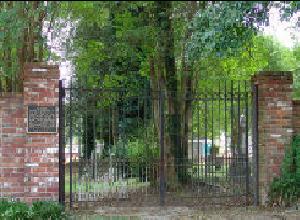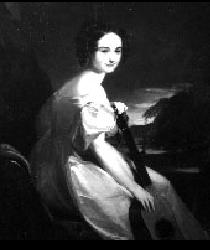
|
Home About This Site Bibliography Contact Us
|
Walker Family Cemetery
Walton Way Augusta, Georgia
The Walker Family Cemetery, located on Arsenal Avenue in Augusta, Georgia, has been cited as one of the most historic cemeteries in the state. It was established by Freeman Walker. When he sold the land for the arsenal he retained an acre within the boundaries of the sale for a family cemetery, which already contained the graves of several relatives.
Freeman and Mary Garlington Creswell Walker had nine children, five of whom survived childhood. Sons William Henry Talbot and John David pursued military careers.
John David Walker enlisted early in the war. As a major in 1862, he commanded the First Georgia Regulars and was wounded in August of that year in the second battle of Manassas. The leg injury became gangrenous and resulted in his death. Although he was originally buried near the battlefield, later in 1871, he was interred in Walker Cemetery.
William Henry Talbot Walker , who was born in 1816, graduated from West Point in 1837; commissioned a second lieutenant, he served under Colonel Zachary Taylor in the Seminole War during which he was wounded three times. Walker also saw action in the Mexican War when in a two-year span, 1846-1847, he received three promotions, the last being to lieutenant colonel. Again wounded in combat, his recovery from this injury required over a year. To honor his bravery in both conflicts, the State of Georgia presented him with a sword. When he was able to return to duty, W.H.T. Walker was at first an instructor at West Point and later assigned to the frontier.
When Abraham Lincoln won the presidential election of 1860, Walker resigned from the army and became active in the secession movement. When moderates obviously controlled an Augusta town meeting at the City Hall in December, Walker led the secessionists from the building to rally on the steps. The following month, Georgia seceded and the U.S. Arsenal on "the Hill" became a Union enclave. At first refusing a call to surrender, Commandant Arnold Elzey reversed his earlier decision when local militia units began to assemble in the downtown area. He requested that he be allowed to relinquish his sword to W.H.T. Walker, a former classmate at West Point.
Walker joined the Confederate Army as a brigadier general and after a brief assignment in Florida, he was transferred to Virginia. Before long, he was unhappy with what he felt was preferential treatment being given to certain officers. A month after he resigned, Georgia Governor Joseph Brown gave him command of the 2nd Georgia Brigade, assigned to protect the Savannah. By the end of 1862, disagreements over defense strategies between the high command and local officers resulted in Walker's unit being dissolved. In February 1863, Walker rejoined the Confederate Army and in May was promoted to major general. He served at Vicksburg with General Joseph E. Johnston and after that city fell, he was sent to the defend the Georgia-Tennessee border. When the southern forces were unable to prevent the Union penetration into north Georgia, Walker and his men pulled back to Atlanta. General W.H.T. Walker was killed in the Battle of Atlanta on July 22, 1864. His funeral cortege from the train depot downtown Augusta to Walker Cemetery on the hill consisted of the Palmetto Band, military units, and a long procession of carriages. Walker's statue, representing the City of Augusta, is one of the four generals depicted on the Confederate Monument on Broad Street which was dedicated in 1878.
Octavia Celestia Valentine Walton, the daughter of George Walton, Jr. and Sarah Minge Walker Walton, was born on August 11, 1811. In 1835, George Walton, Jr. and his family moved to Mobile where, within a year, Octavia met and married Dr. Henry Le Vert. Of the five children born to the couple, only two daughters survived. Octavia Walton Le Vert, Jr. was nicknamed "Diddie" by the family and Henrietta Caroline, named for Henry Clay, was called "Cara Netta."
For many years Octavia and Henry Clay had corresponded frequently, and he had visited her family in Mobile. When the cornerstone was laid for a monument in his honor in New Orleans in 1856, Octavia Walton Le Vert was asked to deliver one of the tributes to the late "Great Compromiser."
The home of the "Madame" Le Vert , or "the Countess of Mobile," as she came to be called, was a magnet for the political, social and intellectual elite who visited the city. Through her discussions and correspondence with Henry Clay, Octavia Walton Le Vert came to believe that compromise was far better than conflict. Therefore, when the talk around Mobile turned to secession, she supported the preservation of the union through compromise. Most of Mobile turned on her and rumors even circulated that she was a "Yankee" spy, who had searched the papers of Confederate General P.G.T. Beauregard while he was a house guest. Upset over the accusations, the general wrote a denial of the rumors. But, "Madame" Le Vert keenly felt the resentment she endured in Mobile both during and after the war. After several years of periodic travel, even two years touring as a public reader, she returned to her birthplace, Augusta. Octavia Walton Le Vert died on March 12, 1877, and was buried in the Walker Cemetery. As the years passed, the people of Mobile forgot the gossip and remembered her with admiration and respect. In the restored "Oakleigh" House, a room was dedicated to the memory of the lady who had been called the "Countess of Mobile."
|
| © 2007 John Rigdon |




